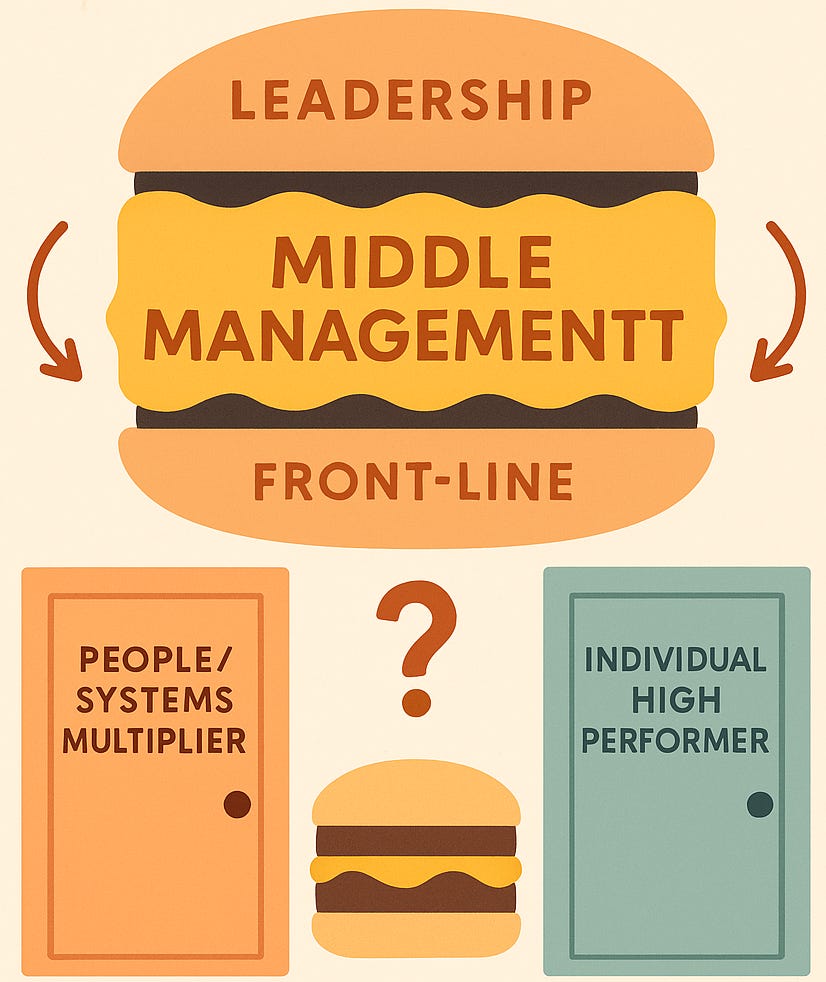Middle Managers Face a Defining Moment in the Next 12 Months: Two Winning Paths
A Playbook for Navigating Middle-Management Job Disruption
I spend my time between C-suites and front-line teams. I'm also deeply AI-forward. What strikes me most is the dangerous gap between what senior leaders expect and what middle managers are preparing for. The change isn't gradual anymore. It's structural, and it's accelerating. Most headlines of AI replacing jobs are focused on the entry level. Postings for entry roles most exposed to AI have fallen, and the anxiety is real.
What is less discussed is the squeeze on the middle management. Here's what I'm seeing:
AI tools are eliminating 20–30% of coordination tasks that justified management layers. Cost pressure is forcing middle management cuts by 15–20% while expecting the same outcomes. Large companies have asked some managers to shift into individual contributor roles to reduce bureaucracy and speed decisions. The math doesn't work with the old playbook. But this isn't a crisis if you see it clearly and act decisively.
The old management contract is breaking. Traditional middle management served three core functions:
Information hub: Collecting, filtering, and routing information up and down
Coordination engine: Scheduling, aligning, and managing handoffs
Capacity multiplier: Developing people and removing blockers
Why this is happening now: three forces are converging:
AI absorption of routine work: AI automates information collection, coordination, and oversight. It plans, sequences, drafts, checks, and routes work. Tasks that once consumed a manager's week are becoming part of daily tools. The trains can run without as many conductors.
Leaders want shorter paths from strategy to customer: Each review step adds delay and risk. Removing layers speeds decisions and brings leaders closer to the market.
Cost pressure favors delayering: When capital is expensive and growth uneven, fewer layers look like a clean productivity lever.
What remains is the human work: judgment, relationship-building, and capability development.
A caution: Boss-less organizations rarely work
Companies have tested extremes. Some removed middle management entirely and tried flat models. Results were mixed. Employees struggled with alignment and hidden power centers returned through unofficial channels. The lesson is simple: some management is essential. It just needs to be different from what it was.
Practical options I see working for middle managers:
Path 1 = Systems/People Multiplier (build capabilities, processes, org design)
Goal: multiply the speed and quality of others. How this looks in practice:
Design org structures that flex up and down with demand
Take on the most complex, ambiguous projects, break them into automated workflows and human-in-the-loop steps, then delegate once the structure is in place
Replace status meetings with training and mentoring sessions that upskill team members so they become capability builders
Skills to stack in the next 6 to 12 months:
AI fluency for managers: scope the problem for tools, evaluate outputs, protect privacy, fit into daily routines
Cross-functional facilitation with fewer meetings and crisper decisions
Org design basics: spans, layers, and when to flex them
Field note: In my CMO role, roughly 60% of my time goes into building and evolving systems that others can use. This includes areas like content strategy, analytics, channel activation, and process infrastructure using AI and agentic tools. The remaining 40% is dedicated to unblocking teams and driving cross-functional alignment. It’s not the neat divide of pure management or pure individual contribution, but it’s a deliberate blend that keeps me on the front edge of AI innovation while accelerating my team’s growth. This systems-multiplier path is a marked shift from traditional management, and it’s the one I’ve chosen.
Path 2: Individual High Performer (own outcomes directly with your expertise)
Goal: own outcomes directly where your craft is sharpest.
Sometimes the right move is to pick your strongest craft and put points on the board. That might be growth experimentation, product marketing, data, design systems, or partnerships. Markets are already nudging managers in this direction.
How this looks in practice:
• Choose a domain where your judgment beats a generic tool. Build an AI-accelerated stack and solve a problem that is tough to crack
• Share your learnings in public. When you do that, focus on wins that matter. Use time to impact, revenue or cost per result, and learning velocity. Skip vanity metrics.
How to pick your path ? Ask three questions:
Where do you create surplus fastest: by making ten people faster, or by delivering the hardest ten percent yourself?
What 90-day proof can you ship that shows your edge in the new reality?
What is your company signaling right now: delayering that elevates individual contributors, or investment in capability building?
The mindset shift
This isn't about being demoted from management. It's about evolving from coordinator to value creator. Many top individual contributors earn more than traditional managers because they deliver direct impact on business outcomes.
The companies winning right now have flatter structures, faster decision-making, and clearer accountability. The number of middle managers will fall and the nature of the role will change. The winners will be those who multiply others or deliver outcomes directly.
If you manage in the middle, do not argue with the tide. Pick a lane. Become the person who makes teams better and faster, or become the person who ships the work that matters.
The org chart is flattening either way. Your career does not have to.



